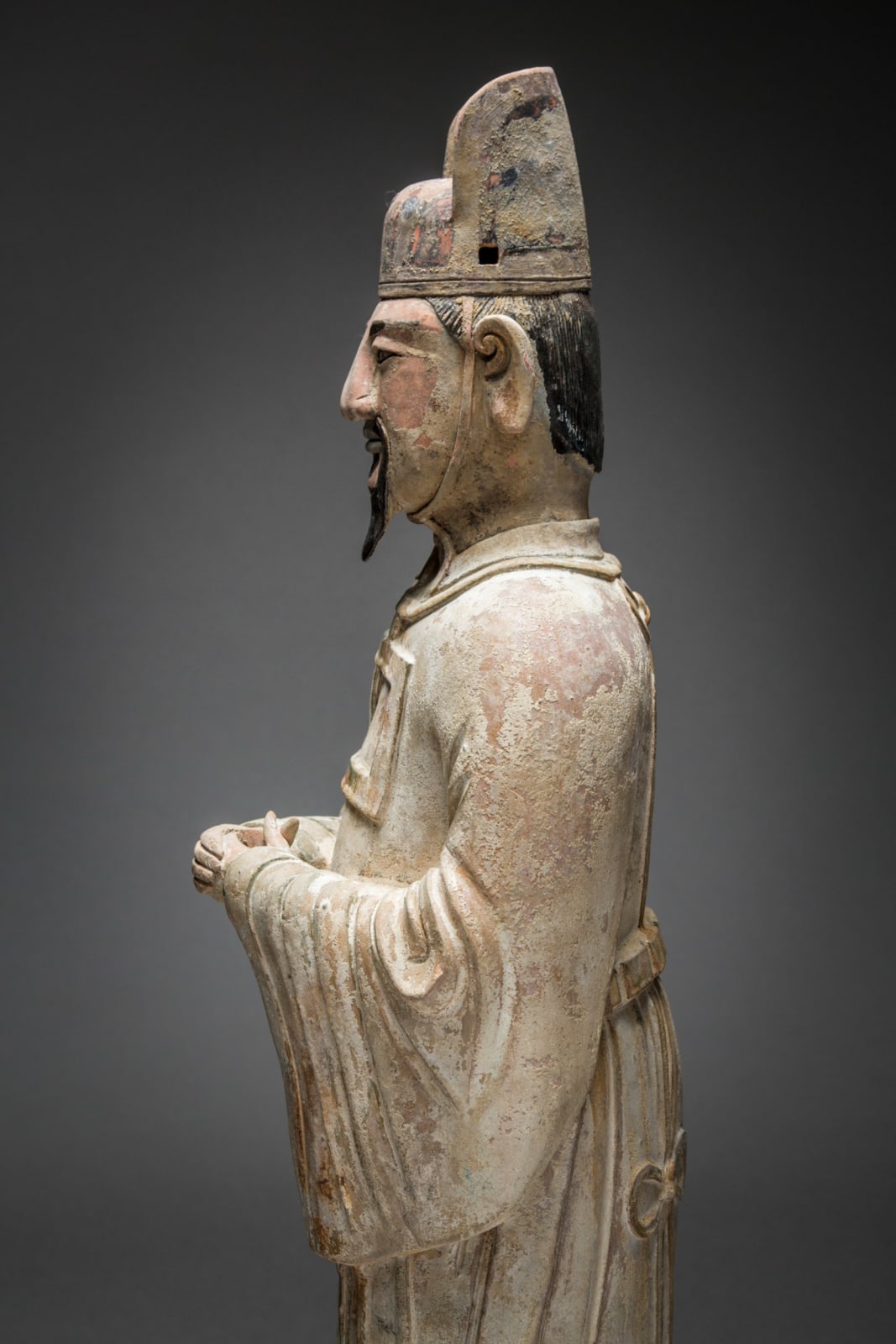Ming Painted Terracotta Civic Official, 1368 CE - 1644 CE
Painted Terracotta
86.4 x 34.3 x 28.6 cm
34 x 13 1/2 x 11 1/4 in
34 x 13 1/2 x 11 1/4 in
H.1094
Further images
Upon leading a victorious rebellion against the foreign Mongul rulers of the Yuan Dynasty, a peasant named Zhu Yuanzhang seized control of China and founded the Ming Dynasty in 1368....
Upon leading a victorious rebellion against the foreign Mongul rulers of the Yuan Dynasty, a peasant named Zhu Yuanzhang seized control of China and founded the Ming Dynasty in 1368. As emperor, he founded his capital at Nanjing and adopted the name Hongwu as his reign title. Hongwu, literally meaning “vast military,” reflects the increased prestige of the army during the Ming Dynasty. Due to the very realistic threat still posed by the Mongols, Hongwu realized that a strong military was essential to Chinese prosperity. Thus, the orthodox Confucian view that the military was an inferior class to be ruled over by an elite class of scholars was reconsidered. During the Ming Dynasty, China proper was reunited after centuries of foreign incursion and occupation. Ming troops controlled Manchuria, and the Korean Joseon Dynasty respected the authority of the Ming rulers, at least nominally.
Like the founders of the Han Dynasty (206 B.C.-220 A.D.), Hongwu was extremely suspicious of the educated courtiers that advised him and, fearful that they might attempt to overthrow him, he successfully consolidated control of all aspect of government. The strict authoritarian control Hongwu wielded over the affairs of the country was due in part to the centralized system of government he inherited from the Monguls and largely kept intact. However, Hongwu replaced the Mongul bureaucrats who had ruled the country for nearly a century with native Chinese administrators. He also reinstated the Confucian examination system that tested would-be civic officials on their knowledge of literature and philosophy. Unlike the Song Dynasty (960-1279 A.D.), which received most of its taxes from mercantile commerce, the Ming economy was based primarily on agriculture, reflecting both the peasant roots of its founder as well as the Confucian belief that trade was ignoble and parasitic.
Traditionally in Chinese art, representations of civic officials symbolized the order of government. However, this gorgeous sculpture of a civic official, created during the Ming Dynasty, symbolizes more than mere government, it symbolizes the return of the ethnic Chinese to power. Aesthetically, the work recalls similar depictions of civic officials created during the T’ang Dynasty, a golden age of Chinese culture. Surely this visual link to the glories of the past is not unintentional. This official stands upon a substantial base, revealing his revered position within society. He is no mere administrator; he is the embodiment of the will of the Emperor. An elegant robe with long overflowing sleeves frames his body. The tall cap with a chinstrap marks his official status. His facial features and groomed goatee reveal his native Chinese ethnic origins. Remnants of the original pigment that once covered this work are still visible, including orange highlights on the robe and black on his facial hair, cap, and shoes.
Like the founders of the Han Dynasty (206 B.C.-220 A.D.), Hongwu was extremely suspicious of the educated courtiers that advised him and, fearful that they might attempt to overthrow him, he successfully consolidated control of all aspect of government. The strict authoritarian control Hongwu wielded over the affairs of the country was due in part to the centralized system of government he inherited from the Monguls and largely kept intact. However, Hongwu replaced the Mongul bureaucrats who had ruled the country for nearly a century with native Chinese administrators. He also reinstated the Confucian examination system that tested would-be civic officials on their knowledge of literature and philosophy. Unlike the Song Dynasty (960-1279 A.D.), which received most of its taxes from mercantile commerce, the Ming economy was based primarily on agriculture, reflecting both the peasant roots of its founder as well as the Confucian belief that trade was ignoble and parasitic.
Traditionally in Chinese art, representations of civic officials symbolized the order of government. However, this gorgeous sculpture of a civic official, created during the Ming Dynasty, symbolizes more than mere government, it symbolizes the return of the ethnic Chinese to power. Aesthetically, the work recalls similar depictions of civic officials created during the T’ang Dynasty, a golden age of Chinese culture. Surely this visual link to the glories of the past is not unintentional. This official stands upon a substantial base, revealing his revered position within society. He is no mere administrator; he is the embodiment of the will of the Emperor. An elegant robe with long overflowing sleeves frames his body. The tall cap with a chinstrap marks his official status. His facial features and groomed goatee reveal his native Chinese ethnic origins. Remnants of the original pigment that once covered this work are still visible, including orange highlights on the robe and black on his facial hair, cap, and shoes.
Provenance
Collection of Miss Bonnie Lai 1965Po Yuen Tong Gallery Hong Kong, 2004







